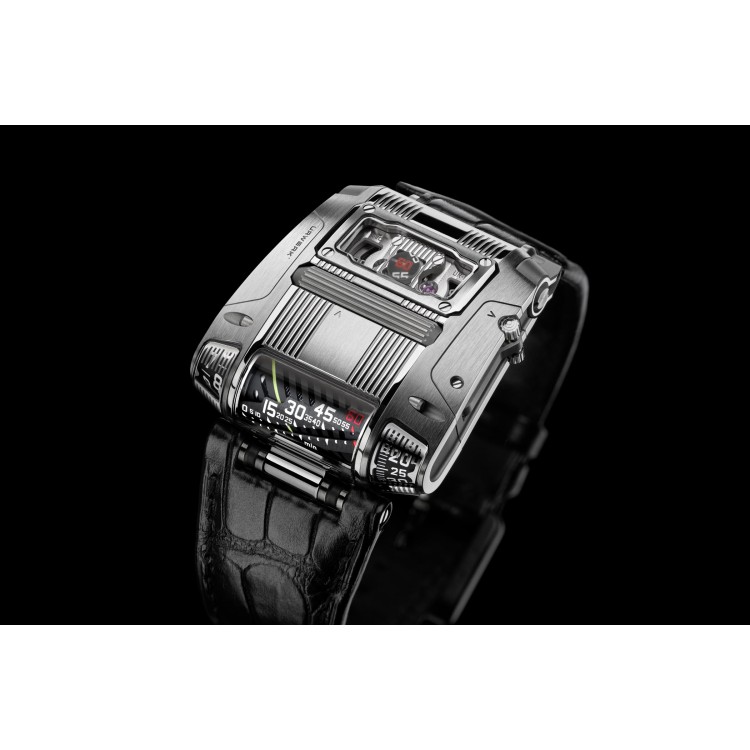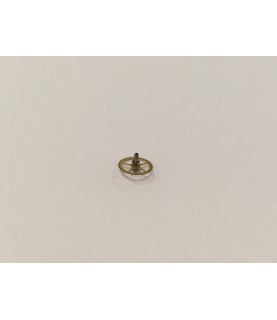Urwerk Strikes Back

Urwerk's latest timepiece, the UR-111C, is a direct descendant of the UR-CC1 King Cobra from 2009 (which itself was inspired by a Patek Philippe prototype created by Louis Cottier and Gilbert Albert in 1959), but it differs in a number of ways. By borrowing the retrograde linear display from the UR-CC1, Urwerk has once again eschewed its recognizable wandering indicator in favor of a brand new timetelling system that involves optical fiber, dual minutes indicators, and a roller set in the middle of the watch that functions as its crown. The UR-111C appears as an avant-garde drivers' watch with the hour and pair of minute indicators most directly visible from the interior-facing side. Hours are displayed digitally on a truncated cone on the left side; a skeletonized helix/cylinder displays the minutes linearly and stretches diagonally across the face of the watch; the second minutes display is located to the right on its own truncated crown and shows the time digitally for enhanced precision; and the seconds are told in 5-second intervals via two rotating plates set deep within the movement and brought to the face of the watch via an image conduit constructed of optical fibers.

Where the original King Cobra was focused on a very flat perception of time through its usage of closed cylinders, only allowing for the slow crawl of the hours and minutes to be seen via an aperture, the UR-111C delights in its three-dimensionality. The helix/cylinder used for the progressive minutes opens the watch up and shows the deliberate passage of time as the cylinder rotates 300 degrees to the final minute of the hour before a coiled spring snaps it forward for the final 60 degrees and back to its starting position at the beginning of the hour. The digital minutes display – which differs from the UR-CC1 with its single hour and minutes display and dual seconds indicator – is meant for precision timekeeping, while the linear aspect is meant to demonstrate time's fluid nature. For the first time in horological history, a roller set on the watch's case performs the duty of the crown. Rather than using a crown directly attached to a stem, a roller is set parallel to the winding stem. To wind the watch, all you have to do is push the fluted roller along just as you would a rolling pin in the kitchen. To set the time, a lever set adjacent to the roller on the indented side of the case must be pulled out to be set either forward or backward. In our opinion, it's one of the most fascinating time setting mechanisms of 2018. Read on as Felix Baumgartner, Co-founder of Urwerk, discusses the development of this experimental timepiece.

LRB: You've made a King Cobra
before. What made you return to it? FB: For us, it was just a natural thing to do because we love the idea of the linear time indication, which came from when I was a child. I loved American wide horizontal landscapes, and in Switzerland, we have mountains, and the horizon is not so far. In the U.S., it looks wider. The American [cars] from the '50s had these speedometers with this linear indication, which was very long and wide. These images are my childhood vision of America. LRB: How long was the watch in development? FB: Some three years plus. LRB: The original King Cobra CC1 displayed the seconds both digitally and linearly. With the new watch, you're showing the minutes digitally and linearly. Why the shift there, from seconds to minutes? FB: We still have the seconds. [With the CC1] we had one big wheel having the digits in a spiral showing the linear. Here we have only the digits. What we wanted to show here, with that optical transmitter, is to actually have the seconds down in the movement, projecting it up through the optical fiber. I think the effect is surprisingly cool if you see that they are floating here on the top, but are actually down in the movement. And on top is a real challenge because the distance between the optics and the digits, it's 2/100 of a millimeter. So the assembling of the wheels and the digits is an incredible work of precision to make sure that optical transmitter works.

LRB: Something I noticed about the original King Cobra was that the linear display moved via hidden cylinders in the background. Here you've opened it up, where you can actually see the cylinder that can change the time, and wind it. Plus, you can see the helix in front. What was the thought process behind opening it up and making the cylinders visible? FB: It helps for visibility, because, let's say it's 30 minutes after, you see the line actually starting on top, going through the rest of the hour, and then going back. So you actually see the positioning. The quick view is actually the easiest, it helps the visibility. I always love to see underneath the mechanics. I think Urwerk is one of the first companies who provide that aesthetical pleasure, to see the three-dimensional mechanisms. Here you can really look and understand how it works. On the first Cobra, we went more for understatement, with just a tiny indication. On the [UR-111C], it's more three-dimensional. You could say that between the first Cobra and now, we've moved into the third dimension.

LRB: How does it feel to be moving further away from the wandering-hour display that you were known for? FB: Technically, there are two research centers at Urwerk now. One is different time indications. We reinvent the satellite [indicators] every two to three years. We continue researching this. In parallel, we started the Cobra, so this is linear, so we continue here the linear research. And then the other family is chronometry, so it's the EMC, which brings the electronic and mechanical world together. That's a totally different league; it's different ambitions. LRB: How did you come to use optical fibers for the seconds display? FB: The first idea was to create the digital seconds [using two small wheels], because on the first prototype, we had it on one big wheel and we had some power issues, because on one big wheel you need much more power. When you have two small wheels, you have to have it displayed on two discs, you need less energy to make them work. It's just a physical reality. We pushed them to the limit. We skeletonized, and pushed them to the limit, but even then on the first Cobra it took us 20, 25 degrees of amplitude and that's too much. That's the prototype, it's not really good. Here, we are like 10, 12 degrees, so it takes less energy. And that was the first idea, and then we thought, "Oh shit, they are very deep down in the movement." How can you bring them up? [Cofounder] Martin [Frei] has one of these transparent stones, a natural stone that is [clear], and we thought, "That's cool." And then we found two companies in Europe that are producing [materials] like that, I think for medical instruments. We contacted them and one of those two were able to do something with our measurements, with our demands.

LRB: The idea for the roller, where did that come from?
FB: I think that was Martin because he fought for the case shape. This is a design idea. It's not a technical idea because we don't need that crown to make this movement work, it was an aesthetic idea. And then, actually, it kind of creates technical issues because we have to transmit the power from here into the movement, so we have to go all around and in the case from the sides. So it doesn't make it easier, I'd say.
LRB: You use a base movement, is that correct? With an in-house module?
FB: Yes, actually, we have a base movement, which is a Zenith Elite, to be precise, that is transformed for our needs. However, you cannot recognize the movement anymore. It's been adapted.
LRB: What do you think Louis Cottier would say if he saw the UR-111C?
FB: You know, hopefully, he would be inspired to go on with the [concept]. On his side, I would be interested to see what he is doing. He joined up with Gilbert Albert in the '50s. Gilbert Albert was the designer jeweler in Geneva at the time. The two great artisans, they wanted to create a new brand. Together, they created the Cobra. It was not at all ordered by Patek Philippe. They really wanted to create their own brand.

LRB: And they only made the single watch. FB: Yeah, I think they finished three prototypes. They wanted to try to commercialize, create a brand, but they didn't get it done. So in the end, Patek was happy because Patek was working with both artisans on other projects, so Patek just halts the whole project and says, "Okay, let's just continue work on our [other] projects." In our case, I think that actually these two guys, the designer and the watchmaker, Martin Frei, is the designer, the artist, and I'm the watchmaker. What we did 20 years ago, they tried to do 50, 60 years ago, the same steps. That is why they are kind of a vanguard, and it's cool to make it work, to give that tribute to them. The Urwerk UR-111C is limited to two 25-piece editions in either stainless steel or stainless steel with a gunmetal gray finish (Urwerk hasn't ruled out future releases in other materials). Each watch is sized at 42 mm by 46 mm with 15-mm thickness and comes with a black crocodile leather strap. Both models are priced at CHF 130,000 and are available now.





